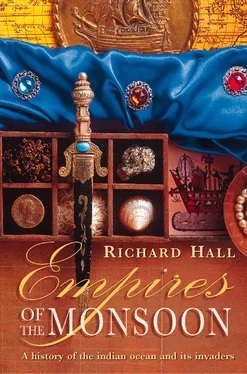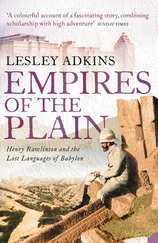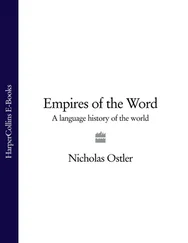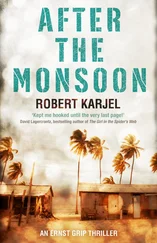So ‘Prester John’ became a title, for bestowal upon the ruler of any suitable Christian kingdom discovered in the East. The name was used in precisely such a way in the Mandeville story: ‘This emperor, Prester John, takes always to wife the daughter of the Great Khan; and the Great Khan also in the same wise the daughter of Prester John. For they two are the greatest lords under the firmament.’ (It demonstrates Europe’s ignorance of events in Asia that the writer seemed unaware that the Mongols, whose ruler was the ‘Great Khan’, had fallen from power almost a century before he was writing.)
As early as 1306, when the Mandeville author had yet to put pen to paper, one scholar had already pointed to Ethiopia as the kingdom of Prester John. It happened because of a remarkable visit to Europe by a thirty-strong Ethiopian delegation sent to the Pope and ‘the King of the Spains’ to seek help against the Muslims. Spain may have been chosen from all the European countries because there was an active Catalan trading station in Alexandria, as well as an Orthodox patriarch who traditionally appointed the head of the Ethiopian Church. If Spanish aid were forthcoming, said the Ethiopians, they were ready to join in a war against the infidels.
The mission apparently gained little, apart from expressions of friendship; but on their way home from Rome and Avignon, where they had been received by Pope Clement V, the Ethiopians were delayed in Genoa by bad weather. A learned priest, Giovanni da Carignano, took the chance to interrogate these strangers, whose looks were so unfamiliar. Being a cartographer, he was keen to learn all he could about the geography of Ethiopia, as well as its customs and religious rites. The Ethiopian king, according to Father Giovanni, was Prester John. Since the visitors would never have called their own king Prester John (his name was Wedem Ar’ad), the title must have been bestowed by Giovanni; since the Prester was by then regarded as being in India, and Ethiopia was commonly called Middle India, this was a reasonable assumption.
Another priest who decided to place the legendary Christian king in India was a Dominican named Jordanus, from the town of Sévérac in southern France. His life-story is obscure, but by his own account he made two hazardous journeys to the East in the early part of the fourteenth century and was granted the title by his religious order of ‘Bishop of Columbum in India the Greater’. (‘Greater India’ was probably seen by Jordanus as embracing South India, Sri Lanka and Thailand; Columbum was the port of Quilon, near Calicut.)
There were Christian communities in southern India, reputedly dating back to the time of St Thomas; the saint is said to have gone to India in A.D. 52 to spread the Gospel and eventually died there. Jordanus was being sent to cajole these wayward believers towards Roman orthodoxy, as well as to win new converts. All the evidence suggests that he made little headway; moreover, although the stories of Prester John and St Thomas had often become tangled together, the adventurous Dominican had been disappointed to find no trace at all of the Christian emperor in India the Greater.
The answer lay elsewhere, and on his return home Jordanus pointed confidently to Ethiopia. While not claiming to have visited their country, the friar had been in ‘Greater Arabia’, where he had learned that the Ethiopians were ‘all Christians, but heretics’. He had a fondness for monsters: ‘Of Aethiopia, I say that it is a very great land, and very hot. There are many monsters there, such as gryphons that guard the golden mountains … The lord of that country I believe to be more potent than any man in the world, and richer in gold and silver and in precious stones. He is said to have under him 52 kings.’ Jordanus also offered a description of East Africa, which he called ‘India Tertia’: it was inhabited by dragons breathing fire, unicorns so fierce that they could kill an elephant, and ‘black, short, fat men’. 6
What Jordanus said about Ethiopia in 1330 marked a decisive stage in relating the legend to a semblance of truth. The friar had almost certainly been helped in his travels by Genoese merchants, and a 1339 map drawn by Angellino da Dalorto, a Genoese, said that the Muslims of Nubia were ‘warring continuously with the Christians of Nubia and Ethiopia, who are ruled by Prester John, a black Christian’.
At last, the kingdom of Prester John, having been sought all across Asia, had come to rest in Africa. While the reality might be far more humble than three centuries of grandiose exaggeration, it was enough to bear Portuguese piety and commercial enterprise along upon the same optimistic wind.
By the fifteenth century there was a small colony of Europeans living in Ethiopia. Almost all were Italians, mainly from Venice, Florence and Genoa. Some had gone to the ‘land of Prester John’ in the hope of acquiring precious stones; others may have become stranded while trying to reach the Indian Ocean by way of the Nile and the Red Sea. One of the earliest visitors whose name has survived is Pietro Rambulo, sometimes referred to as ‘Pietro di Napoli’ (he actually came from Messina, in Sicily, then part of the state of Naples). Rambulo reached Ethiopia in 1407 as a young man, took a local wife soon afterwards, and lived there for forty years.
His influence upon relations between Europe and his adopted home were to be considerable, as first appeared in 1428 when an Ethiopian mission reached Alfonso V of Aragon. The decision by the Ethiopians once again to approach a Spanish ruler, as they had in 1306, was most probably due to lobbying by Rambulo, because Alfonso held Sicily and was on the point of acquiring Naples as well. The emissaries proposed on behalf of Yishaq, the king who had sent them, that the two royal families should be united by marriage: Alfonso should send one of his sons to marry an Ethiopian princess, and an Ethiopian prince would be married to a daughter of Alfonso. The king side-stepped this proposition, but did agree to supply a team of artisans (who all died on the way).
Two years later Rambulo is recorded as accompanying a delegation sent to Ethiopia by the Due de Berry, who had Spanish connections. In 1432 Rambulo halted near Constantinople, and there met the Burgundian traveller Bertrandon de la Brocquière. Since his companions on the delegations had died, Rambulo was doubtless hoping to recruit at least one extra European to present to the Ethiopian monarch. So he ‘made many efforts’ to induce la Brocquière to come with him to Axum, the Ethiopian capital. Although the Burgundian remarks in his memoirs that he had met Rambulo before (without saying where), he also speaks deprecatingly of the fondness of ‘Pietro di Napoli’ for concocting outrageous stories, such as the Ethiopian scheme to divert the Nile and starve out Egypt. Pietro’s offer was turned down.
The failure of the mission to Spain did not seem to lower Rambulo’s standing with Zara-Yacob, the new emperor of Ethiopia, for his next diplomatic mission was to India and China. In 1450 he was again despatched to Europe, with an Ethiopian envoy named Brother Michele, and after a gap of twenty years was once more received in audience by Alfonso of Aragon.
Rambulo now took the opportunity to visit his birthplace. In Naples he was interviewed by a Dominican monk, who wrote down a brief account of the career of this intriguing character. The monk describes Rambulo as being tall, tanned by the sun, handsomely attired and white-haired. This is the last glimpse of him that history affords.
The good fortune of Rambulo had been that he was often allowed out of Ethiopia, whereas other foreigners who came there were not: Zara-Yacob treated them well, giving them wives and land, but refused to let them leave. He may have feared that while on the road they would be captured and tortured by the Muslims to extract information useful in war. Escape for his ‘prisoners’ was impossible, since there was only one route out, northwards to the Red Sea port of Massawa, and that was both hazardous and well guarded.
Читать дальше












